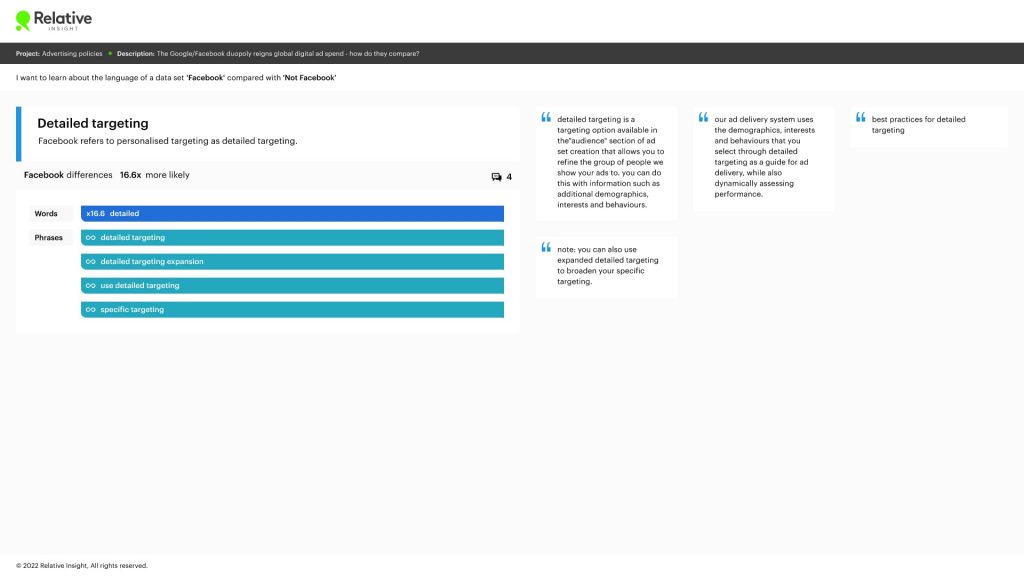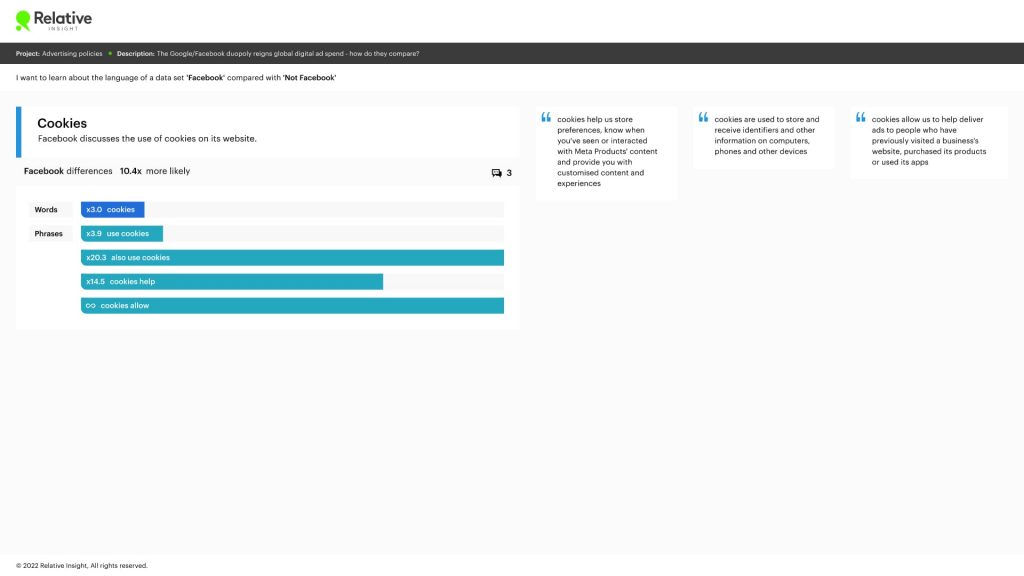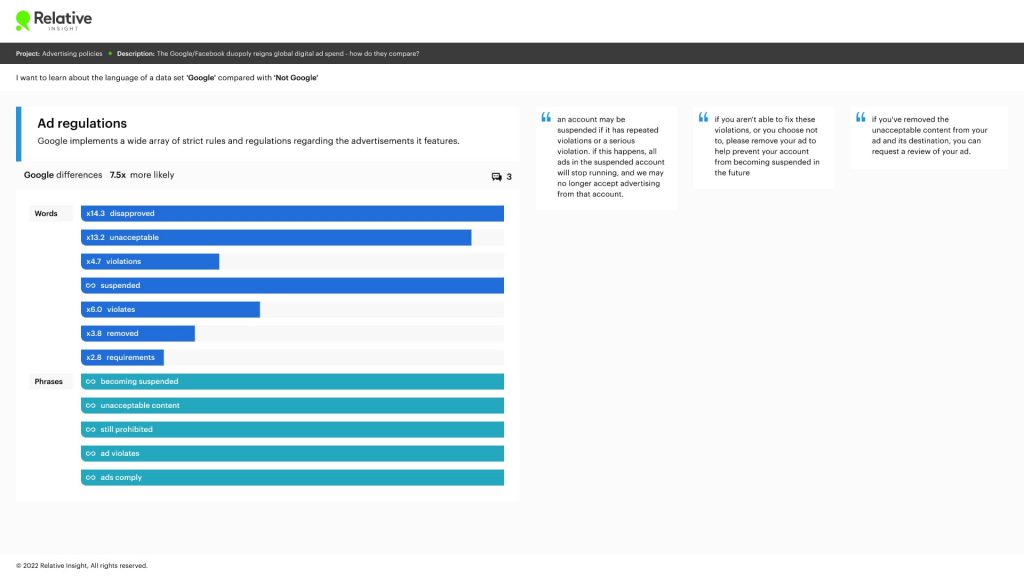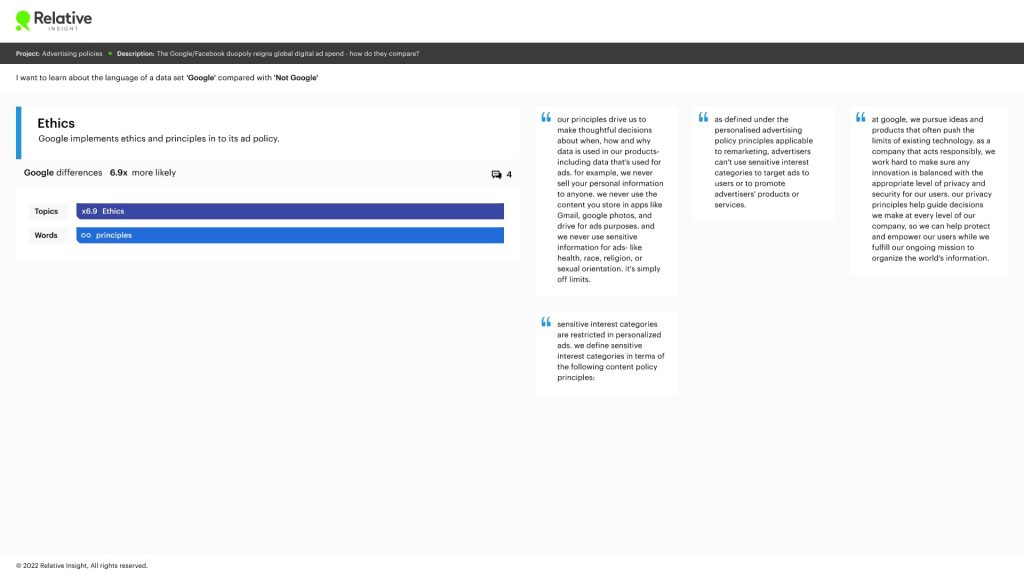Understanding the language of advertising policies

By Nicole Nygate, Account Coordinator
Google and Facebook have a huge impact on billions of lives and reign supreme when it comes to global digital ad spend. As the predatory powers of big data increase, I wanted to investigate how their advertising policies compare and how they affect us.
Using Relative Insight, I compared the language of advertising policies of both firms – focusing on their advertising terms and conditions. My analysis concentrated on the rules governing the content of ads, who advertisers could target and what penalties are in place to enforce the policies. Relative Insight’s Explore tool is able to highlight the topics, words and phrases more commonly used in one text data set compared to another.
Gathering this type of data is referred to as website copy, with pages from one website scraped and uploaded to the tool to be compared to corresponding pages from another site. These insights are valuable for competitor analysis, allowing a brand to understand how it speaks compared with another. The tool can also be used to compare any other sources of text data, as well as standard English, highlighting the nuances in language around a certain topic, brand or product.
Facebook’s advertising policy
In contrast to adopting the commonly-used phrase ‘personalised targeting’, Facebook opts for ‘detailed targeting’ when discussing its micro-targeting policy. The phrase detailed targeting did not surface at all in the Google data set, signifying Facebook is unique in this approach. This choice of words perhaps reflects Facebook’s desire to avoid associations with personalised targeting following previous scandals. Alternatively, Facebook – potentially acting on insight gleaned through a text analysis tool such as Relative Insight – may regard detailed targeting to be a more user-friendly expression.


In regard to the content of Facebook’s policy, the company is 10.4x more likely to discuss the use of cookies and their subsequent effect on users. We might have expected Google to illustrate the use and benefits of cookies on its site, however, this detailed explanation of cookies is unique to Facebook’s approach. This could be rooted in Facebook’s need to be more overt in its use of personally identifiable information (PII). It could also be assumed that Facebook, in pursuit of a better brand image, has had to seriously consider how it communicates with stakeholders.


Google’s ad policy
This comparison of the language of advertising policies showed that in contrast to Facebook, Google implements very strict rules and regulations regarding the advertisements featured on its website. Google’s ad policy goes into detail explaining what constitutes an acceptable advert, possible advertising violations and causes for suspension of advertiser accounts. This highlights that Google has an intense vetting process for content featured on its site. Consequently, Google appears to adopt a user-centric approach which enables people to trust the firm to act in their best interest.


This notion of users being able to trust Google is reinforced by another insight our tool was able to highlight – the presence of ethics and principles in its ad policy. Compared to Facebook, the topic of ethics was 6.9x more common and the word ‘principles’ infinitely more prevalent in Google’s policy. It can thus be inferred that Google places a big emphasis on communicating that the firm functions in a moral and ethical way.


How to apply insights
Using these insights from the comparison of the language of advertising policies, users are able to better understand how firms that collect an abundance of data on them discuss such information. Additionally, the companies themselves are able to acknowledge how they communicate in relation to their competitors to see what works and what doesn’t.
This analysis not only aids increased user understanding of the terms and conditions they accept across different platforms but also enables companies to understand how other firms position themselves and communicate with their users and customers.
